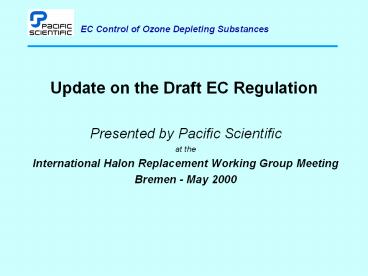Update on the Draft EC Regulation - PowerPoint PPT Presentation
Title:
Update on the Draft EC Regulation
Description:
Airline is the Critical User, not Service Provider. ... They are gambling on the Airline's future, because the Halon price could be ... – PowerPoint PPT presentation
Number of Views:19
Avg rating:3.0/5.0
Title: Update on the Draft EC Regulation
1
Update on the Draft EC Regulation
- Presented by Pacific Scientific
- at the
- International Halon Replacement Working Group
Meeting - Bremen - May 2000
2
Update on the Draft Regulation
- Background and Status
- Halon
- Controls
- Critical Use
- Import / Export
- Impact for Aerospace
- Airline Strategy
3
Background
- New Regulation first seen in draft form in Aug
1998. - Proposes controls on the production, use, sale,
import, export and recovery of ODSs, including
Halon. - Includes Halons, CFCs HCFCs etc.
- Will replace regulation 3093/94, which prohibited
production of Halon and other ODSs.
4
Current Status
- 2nd reading of the EU Parliament Dec 99
- Some outstanding issues on HCFCs
- Halon aspects are agreed.
- Could be adopted June 2000.
5
Current Status - Entry into Force
- Probable date is 1st October 2000.
- UK and others suggested 1st Jan 2001 to allow
time for national ratification. - Will supersede current national legislation in
those countries which already have local controls
(e.g. Germany)
6
Halon Controls (Article 4)
- Prohibits sale or use of Halons after entry into
force, except as allowed below - Use and sale of recovered/reclaimed Halons in
existing systems until 31 Dec 2002 - All systems and extinguishers must be
de-commissioned by 31 Dec 2003. - Exceptions for critical uses which are listed in
Annex VII of the regulation.
7
Critical Uses of Halons (Aircraft)
- Halon 1301
- In Aircraft for the protection of crew
compartments, engine nacelles,cargo bays and dry
bays. - Halon 1211
- In hand-held fire extinguishers and fixed
extinguisher equipment for engines for use on
board aircraft - In Aircraft for the protection of crew
compartments, engine nacelles, cargo bays and dry
bays
8
Import Controls (Articles 6 7)
- Import Licensing
- The restrictions are similar to those in 3093/94.
- An Import Licence issued by the Commission is
required for bulk imports. There will be
quantitative limits. - Affects both Free Circulation and IPR imports.
- Free Circulation import only permitted for
essential or critical use or destruction. - In the event of a Halon shortage, obtaining an
import Quota/Licence is likely to be a protracted
process. - No restrictions on products for critical uses.
9
Export Controls (Articles 11 12)
- Export of products and equipment containing Halon
will be permitted for Critical Uses - It is understood that bulk export of Halon will
not be permitted, even for Critical Uses - Applies from Entry into Force date.
- Export Licences issued annually with quantity
limits and stated destinations. - Applications will need the support of the
national enforcement agency.
10
Impact for Aviation
- Users need to secure supplies before phase-out
date. - Affects non-EC users that are dependant on EC
Service Providers. - Airline is the Critical User, not Service
Provider. - Service Providers are unlikely to accept the full
risk of Investment / Destruction Costs. - US shortage of Halon could affect new aircraft
deliveries ? - Waste Bin Extinguisher not a Critical Use?
11
Factors Affecting Future Needs
- Unknown existing stocks (Banked or Installed)
- Unknown end dates for each application.
- Fleet growth
- New regulation (D to C, etc.)
- Consumption ( Fires, False Warnings, Hydrostatic
Testing) - Economics, Feasibility and Timescale for a
changeout on existing aircraft. - Emergence of new technologies.
12
Airline / Airframe Mfr Strategy
- Forecast of Future Needs is a priority.
- Strategy for continued availability.
- Airline Halon Bank
- Contracted Halon Bank or Contracted Supplies.
- Plan should consider the risk of a US Shortage
- Possible need to source the Halon needed for new
aircraft. - Regular purchases during Phase-out
- Minimise Financial Impact/Availability risks.
13
Support from Service Providers
- Provider/Repair Station probably can
- Assist with the Airlines requirements forecast.
- Assist with the sourcing of Halon before
Phase-out. - Provide recovery and banking facilities.
- Provide ongoing Overhaul and Recharging
facilities. - Provider/Repair Station probably wont/cant
- Provide or guarantee the needs of the industry
from their own resources. - Take the risk of subsequent destruction costs
unaided. - Stabilise Halon prices - now a commodity.
14
Conclusion
- Airlines and Manufacturers need
- A forecast of future Halon requirements, which
includes a What if analysis. - A plan on how this will be provided.
- The plan should be reviewed regularly to take
account of changing availability and alternatives
progress. - Active management of their Halon source, either
through an Airline Bank, a Contracted Bank or a
Supply agreement. - Waste Bin Extinguisher replacement ?
15
Finally
- If an Airline is going to rely on a Supplier
agreement alone - They need to be pretty confident the supplier
will still be in business and able to supply when
Halon is needed. - They are gambling on the Airlines future,
because the Halon price could be nothing, or a
fortune.



























